 © EuroFootball.com
© EuroFootball.com
Today in "Tribūnas" we start a series of articles about historical World Cup football stadiums - all this is offered to you by EuroFootball.com visitor JC Denton.
A stadium is an exceptional gathering place for people. Here tens and hundreds of thousands of people gather, here the attention of everyone is captured by top-level matches. Here the most sacred hopes of sports fans come true and die. Here people are born and sadly... die. Here football player's careers, team eras begin and end. Here great history is created - football, city, sometimes - country.
Approaching the World Cup, we will present a section about the most famous football stadiums to our readers every week. Some may be surprised why we will not mention stadiums like Nou Camp, Old Trafford, Delle Alpi, Anfield, Amsterdam Arena, etc. In fact, we could find about a hundred worthy feathers on the cap of sports arenas. However, in the reviews, we will only discuss the stadiums where the finals of previous World Cup matches took place.
In 1930, in Uruguay. Estadio Centenario - a symbol of the state. Current number of seats: 73,609 Opening: 1930.
By including football in the list of Olympic branches, to the surprise of many, the Uruguayan national team triumphed at the 1924 Paris and 1928 Amsterdam Olympics. The football spectacle, where Europeans remained as supporting actors, was greeted with praise from European newspapers of that time. As the popularity of this sport grew, FIFA decided to start organizing World Cup championships. There was no shortage of those willing to start a new page in football history. Among the economically strong Western European countries, Uruguay's application seemed like a joke. However, Uruguayan representative E. Bueras played his trump cards at the negotiating table, which Europeans could not resist: a free trip of national teams by cruise ship, accommodation, meal expenses, and finally they would build a stadium with 100,000 seats (!). The last argument sounded like a surreal mirage. In Europe, including Wembley and Glasgow's "Boiling Pot", there were neither such large arenas nor plans to build them. Therefore, Estadio Centenario had to become the main accent of the championship.
Although the Uruguayan Football Association had strong support from the state government, the promises made to Europeans seemed difficult to fulfill. The construction of Estadio Centenario began on July 21, 1929. The giant of a hundred thousand seats had to be built in less than a year. The planned location of the stadium was the southern suburbs of the country's capital, Montevideo. The design, engineering, and construction works were supervised by architect A. Scasso. Stadium type - open, height - 24 meters above sea level.
The works were burdened by many circumstances - a lack of qualified labor, poor city infrastructure, unfavorable weather conditions (prolonged rains), and finally - the global economic crisis of 1929. However, all adversities were compensated by the sacrificial determination of Uruguayans. The great Estadio Centenario had to become a symbol of Uruguay's independence centenary and state prosperity. For 15,000 workers and the entire Nation, the stadium became the most important issue in life. They worked without weekends. Construction works took place around the clock. The stadium was built by three shifts, changing every 8 hours.
With 2 months left until the start of the championship, it turned out that due to safety and increased technical requirements, the number of seats in the arena had to be reduced to 75,000. This restriction wounded the hosts' ambitions, but their self-criticism was exaggerated. During the years of financial depression, the little country-built Centenario became the largest interwar sports project, and its builders surpassed the construction scales of the pharaohs' pyramids. Five days before the opening of the tournament, the construction works on the stadium were completed.
Without detailing the course of the championship, I will remind you that Uruguay's eleven became champions. The footballers' triumph, the centenary jubilee, the Mass ecstasy of the Nation - all this took place at the Centenario arena. The athletes' victory became a national celebration, and the stadium - a national monument. FIFA General Secretary Henry Delaunay later acknowledged - despite the skill of other teams, Uruguay's loss in the final would have become an unbearable punishment from God, and Centenario - the phantom of unfulfilled dreams in ghostly homes.
For over 75 years, Estadio Centenario has become a true fortress of the national eleven. The Uruguayan national team plays there as if on wings. During 37 Copa America stage matches at this stadium, the hosts have never lost. Not much easier is the fate of friendly opponents. For example, the Brazilian national team won only 2 times in 20 official meetings against the hosts at Estadio Centenario.
Estadio Centenario is also important for Uruguayan club football history. The capital teams - "Penarol" and "Nacional" have fierce derbies there for over 70 years.























